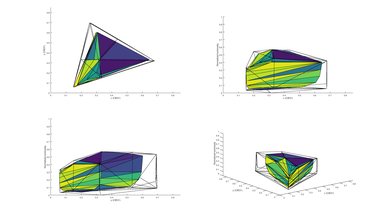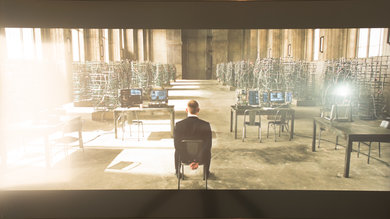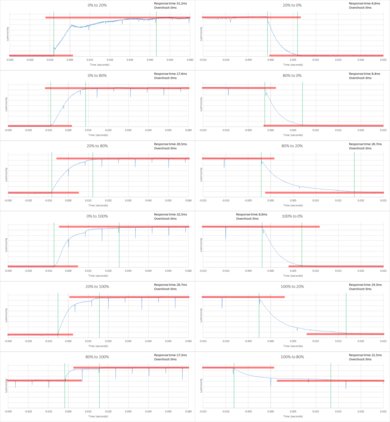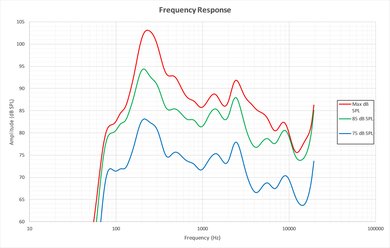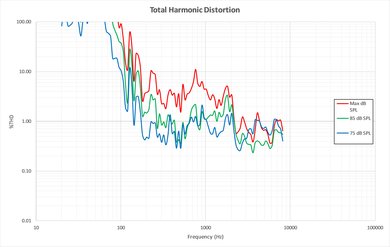The 4k UHD Samsung KU6500 offers good picture quality when viewed from directly in front, but this degrades when viewed at an angle. It is almost exactly the same as the Samsung KU6600, and the Samsung KU6300 (but with a curve). It performs best in a dark room due to the good native contrast ratio. Unfortunately it is average at handling fast motion and although it supports HDR10, it doesn't really benefit from the extra information.
Our Verdict
Good TV for mixed usage. Picture quality is good, and so is dark scene performance. No features such as local dimming to improve it further. Picture quality degrades when viewed at an angle. Motion handling is above average for fast paced content.
-
High native contrast results in good dark scene performance
-
Feels responsive
-
Image loses contrast at an angle
-
Some dirty screen effect
-
Doesn't deal with reflections well
Average for watching movies in a dark room. Picture quality is good, but degrades when viewed at an angle. High native contrast ratio but lacks local dimming feature to improve dark scene performance further. Those sensitive to judder will notice it when watching movies.
Slightly above average for watching TV in a bright room. Average at dealing with reflections. Whole screen can't get bright to fight glare. Picture quality is good, but degrades when viewed from an angle. Smart platform works well for watching media or files on a USB.
Above average for watching sports. Picture quality is good, but degrades when viewed at an angle. Motion blur is slightly better than average. Whole screen can't get bright to combat glare.
Great for console gamers. Input lag is low across all sources, which is great. Picture quality is good. Motion blur is average, which should be ok for most people.
Supports HDR10, but can't really benefit from it. Good picture quality but doesn't support a wide color gamut or high peak brightness to take advantage of HDR content. Lacks local dimming.
Supports HDR10 and can activate game mode for low input lag. Picture quality is good but doesn't benefit from the extra HDR information. Can't display a wider range of colors and can't get very bright highlights.
Good PC monitor. Supports a wide range of resolutions with chroma subsampling for clear text. Feels responsive with low input lag. Picture quality is good and motion handling is average.
- 7.4 Mixed Usage
- 6.8 Movies
- 7.1 TV Shows
- 7.2 Sports
- 8.3 Video Games
- 7.1 HDR Movies
- 7.9 HDR Gaming
- 6.9 PC Monitor
Changelog
Check Price
Differences Between Sizes And Variants
We tested the 55" (UN55KU6500), version FA01. For the most part, we expect our review to be valid for the other sizes.
If someone comes across a different type of panel or if their Samsung KU6500 doesn't correspond to our review, let us know and we will update the review.
| Size | Model |
| 49" | UN49KU6500 |
| 55" | UN55KU6500 |
| 65" | UN65KU6500 |
Popular TVs Comparisons
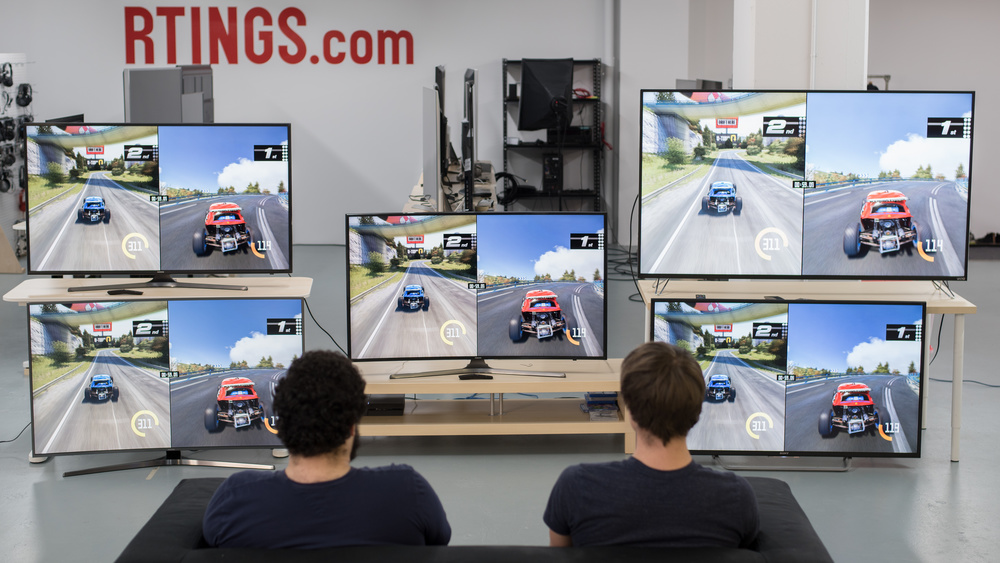
The Samsung KU6500 provides good picture quality, especially in a dark room, but unfortunately it is priced well above the competition. As a result it is up against some higher end TVs, with additional features to improve the picture quality. Keep this in mind when viewing our recommendations below.
Test Results
The KU6500 has the iconic Samsung design, with a central stand which supports the TV well. The stand has a fairly small footprint and is the only visible difference from the KU6600. The back of the TV has corrugations which look OK, but not as nice as some of the higher end models.
The central stand supports the TV well and has a small footprint which is ideal for those with smaller tables. It looks the same as the KU6300.
Footprint of the 55" TV stand: 12.6" x 33.1"
The back of the TV is textured with plastic corrugations. This doesn't look as good as higher end models but the inputs on the side are fairly easy to access, even if wall mounted. It is the same back as the KU6600.
There is no local dimming feature on the KU6500. The 'UHD Dimming' which is advertised is a frame dimming feature, which can only be disabled by activating PC mode. It reduces the whole screen brightness when the scene is mostly dark.
The SDR peak brightness is bellow average for the KU6500 and remains almost the same whether in SDR or HDR mode, which is a good thing, especially for watching normal TV content. At this level of peak brightness, this TV would be best if situated in a darker room.
The peak brightness of small windows is reduced by the 'UHD Dimming'. The effect of this is reduced in 'Movie' mode but the only way to completely disable it is to switch to a 'PC' icon. When in PC mode, the screen brightness is 400 and remains the same at all size windows
The peak brightness stays relatively the same whether HDR is active. This can be seen as a good thing since most of the TV content is in SDR.
The gray uniformity is average and the result is very similar to what we had on the KU6300. All borders are darker leaving the center a bit more warm than the rest of the screen. Some horizontal bands are visible, but overall the center of the screen is smooth. Dirty screen effect is visible, but should not be so distracting.
When viewed at an angle, the contrast of the image is reduced and colors lose accuracy. This is a very similar result to other VA TVs, even the high end Samsung KS* Series. This is okay for fairly narrow seating, but may be distracting for those who regularly watch from an angle.
Update: We have changed the methodology of testing. Since this is an old TV which we don't have anymore, we extrapolated the results.
Black uniformity is very good and is comparable to what you get on the flat version, the KU6300. Some really faint clouding can be seen on our test picture, but nothing at all can be seen when watching movies or normal content.
The TV adjusts quite well using the inbuilt 2 and 20 point white balance. All minor issues are resolved, and the colors appear very accurate. You can see our recommended settings here.
Unlike the KU7500, this TV doesn't have a wide color gamut. The colors of this TV are suitable for SDR content, but cannot display more saturated images for HDR content.
The TV is average at dealing with reflections. It has a semi-gloss finish which diffuses reflections on the screen. This does make them appear larger, but reduces their intensity. The curve of the TV also distorts the reflections, which can be a good thing depending on where the ambient light is coming from. It is not a problem for a room with some glare but may be an issue in a bright room.
The response time of the KU6500 results in below average motion blur following moving objects. This is better than most TVs and should be ok for most people, but may be an issue for fast paced content. It is also about the same result as the KU6600 and KU6300 TVs. The PWM flickering of the backlight can be seen in the duplications following our moving logo.
Judder is experienced when watching movies from any source. This is generally not an issue, as most people aren't sensitive to the small 3:2 pulldown judder.
The input lag is low across all sources when using the 'Game' picture mode, which is good. Changing the input icon to 'PC' to enable chroma subsampling increases the input lag, but this is still quite a good result. This is similar to other Samsung TVs such as the KU6300.
To accept a high bandwidth signal such as 4k @ 60Hz @ 4:4:4, it is necessary to enable 'HDMI UHD Color'. This is only possible on HDMI1. Change the input label to 'PC' to accurately display chroma subsampling for PC use.
For 5.1 passthrough it is necessary to select the correct format in the sound options (DTS or Dolby Digital). It does not change automatically.
Average performance. Frequency response is decent, although at higher volumes pumping and compression will be present. Low-end cutoff is rather poor, even for a TV, but it does get loud enough for most situations.
The KU6500 has the newest version of the Tizen operating system. It is one of the most stable smart platforms, which works well for general use. It is more limited in app availability but all the major apps are present and should satisfy most people out there. When connecting a new device via HDMI, the smart interface will set it up automatically, rendering the use pretty easy. Content like pictures and movies store on USB drive can easily be accessed via the USB port.
When a new device is detected (such as when a computer is woken from sleep while plugged into an HDMI port) the TV automatically switches to this device. This may be an annoyance if you are watching other content at the time.
Comments
Samsung KU6500: Main Discussion
Let us know why you want us to review the product here, or encourage others to vote for this product.





















